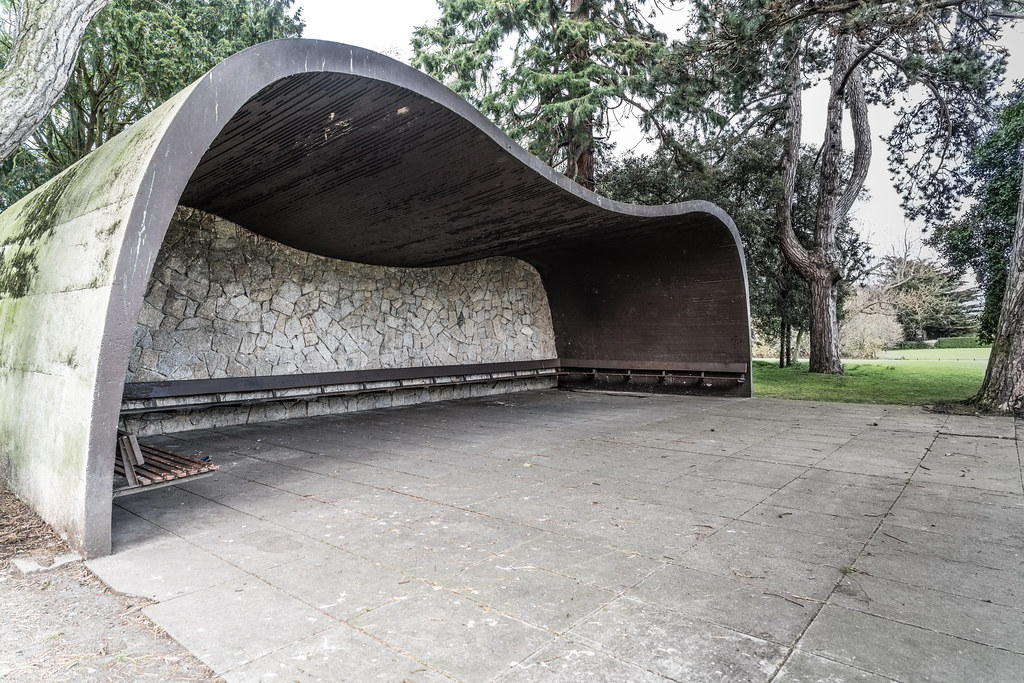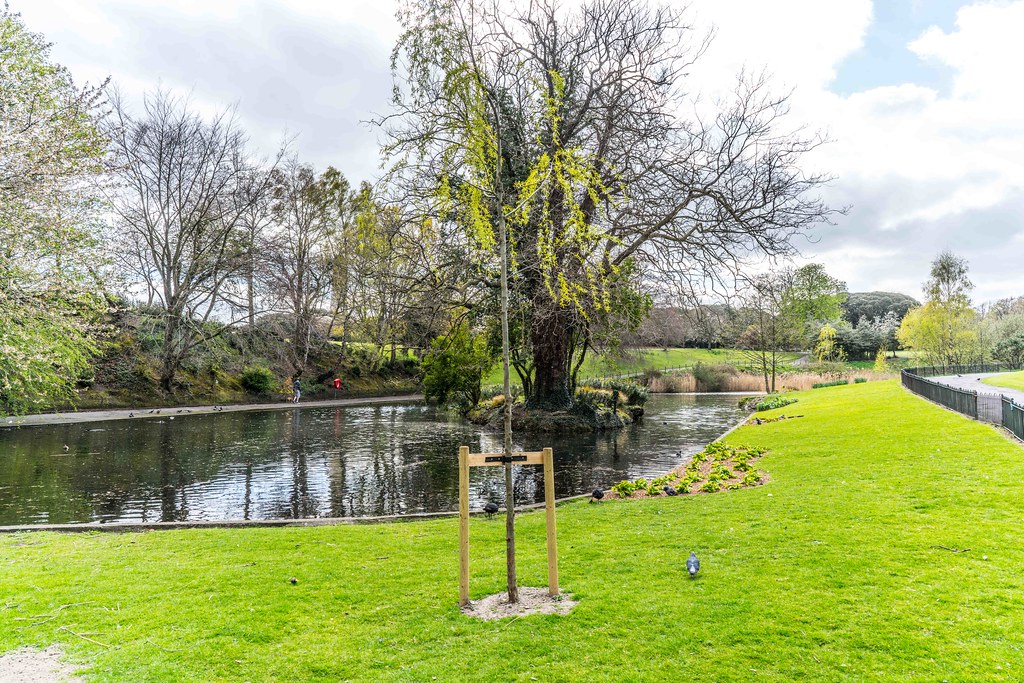WILLIAM MURPHY'S PHOTO DIARY AND CATALOG
Phoenix Park is an urban park in Dublin, Ireland, lying 2–4 km west of the city centre, north of the River Liffey. Its 11 km perimeter wall encloses 707 hectares (1,750 acres), one of the largest walled city parks in Europe. It includes large areas of grassland and tree-lined avenues, and since the seventeenth century has been home to a herd of wild Fallow deer. The English name comes from the Irish fionn uisce meaning "clear water".
The Irish Government is lobbying UNESCO to have the park designated as a world heritage site.
After the Normans conquered Dublin and its hinterland in the 12th century, Hugh Tyrrel, 1st Baron of Castleknock, granted a large area of land, including what now comprises the Phoenix Park, to the Knights Hospitaller. They established an abbey at Kilmainham on the site now occupied by Royal Hospital Kilmainham. The knights lost their lands in 1537 following the Dissolution of the Monasteries under Henry VIII of England.
Eighty years later the lands reverted to the ownership of the King's representatives in Ireland. On the restoration of Charles II of England, his Viceroy in Dublin, the Duke of Ormonde, established a Royal Hunting Park on the land in 1662. It contained pheasants and wild deer, making it necessary to enclose the entire area with a wall. The Park originally included the demesne of Kilmainham Priory south of the River Liffey, but when the building of the Royal Hospital at Kilmainham commenced in 1680, the Park was reduced to its present size, all of which is now north of the river. It was opened to the people of Dublin by the Earl of Chesterfield in 1745.
In 1882, it was the location for two murders. The Chief Secretary for Ireland (the British Cabinet minister with responsibility for Irish affairs), Lord Frederick Cavendish, and the Under-Secretary for Ireland (chief civil servant), Thomas Henry Burke, were stabbed to death with surgical knives while walking from Dublin Castle. A small insurgent group called the Invincibles were responsible.
The Park is split between three civil parishes: Castleknock to the north-west, Chapelizod to the south and St James' to the north. The last named is mainly centred south of the River Liffey around St James' parish church. The Park has its own piece of legislation the Phoenix Park Act, 1925 which includes giving powers to Park rangers to remove and arrest of offenders who disobey its bye-laws, which include "No person shall act contrary to public morality in the Park".
The Irish Government is lobbying UNESCO to have the park designated as a world heritage site.
After the Normans conquered Dublin and its hinterland in the 12th century, Hugh Tyrrel, 1st Baron of Castleknock, granted a large area of land, including what now comprises the Phoenix Park, to the Knights Hospitaller. They established an abbey at Kilmainham on the site now occupied by Royal Hospital Kilmainham. The knights lost their lands in 1537 following the Dissolution of the Monasteries under Henry VIII of England.
Eighty years later the lands reverted to the ownership of the King's representatives in Ireland. On the restoration of Charles II of England, his Viceroy in Dublin, the Duke of Ormonde, established a Royal Hunting Park on the land in 1662. It contained pheasants and wild deer, making it necessary to enclose the entire area with a wall. The Park originally included the demesne of Kilmainham Priory south of the River Liffey, but when the building of the Royal Hospital at Kilmainham commenced in 1680, the Park was reduced to its present size, all of which is now north of the river. It was opened to the people of Dublin by the Earl of Chesterfield in 1745.
In 1882, it was the location for two murders. The Chief Secretary for Ireland (the British Cabinet minister with responsibility for Irish affairs), Lord Frederick Cavendish, and the Under-Secretary for Ireland (chief civil servant), Thomas Henry Burke, were stabbed to death with surgical knives while walking from Dublin Castle. A small insurgent group called the Invincibles were responsible.
The Park is split between three civil parishes: Castleknock to the north-west, Chapelizod to the south and St James' to the north. The last named is mainly centred south of the River Liffey around St James' parish church. The Park has its own piece of legislation the Phoenix Park Act, 1925 which includes giving powers to Park rangers to remove and arrest of offenders who disobey its bye-laws, which include "No person shall act contrary to public morality in the Park".
SORRY FOR THE DELAY
There are 351 identified plant species in the park; three of these are rare and protected. The park has retained almost all of its old grasslands and woodlands and also has rare examples of wetlands. Deer were introduced into the park in the 1660s; the current 400–450 fallow deer descend from the original herd. 30% of the park is covered by trees, mainly broadleaf.
A Birdwatch survey in 2007–08 found 72 species of bird including common buzzard, Eurasian sparrowhawk, common kestrel and Eurasian jay. The great spotted woodpecker, Ireland's newest breeding bird, has been seen in the Park several times.
The park also holds several streams, tributaries of the River Liffey.
In July and August 2006, the then Minister for Health, Mary Harney, issued three orders exempting two new community nursing units, to be built at St. Mary's Hospital in the Park, from the usual legally required planning permission, despite the Phoenix Park being a designated and protected national monument. The Department of Health said the decision was made because of what it called the department's "emergency response to the accident and emergency crisis at the time", although the nursing units, in use since 2008, are mainly for geriatric care.
In a 2009 conservative management plan for the Park, the Office of Public Works (a Department of Finance agency) commented, "...the erection, without the necessity of resorting to normal planning procedures, of two major developments in St. Mary's Hospital illustrates the vulnerability of The Phoenix Park to internal development, which impacts significantly on the essential character of the Park and its unique value as a historic designed landscape." In a section entitled Pressures and Threats on the Park, subsection Planning Issues, the document expressed concern that, "Without appropriate planning designation, there is a risk that development can take place which is not in line with the co-ordinated vision of this Plan." The document warned of similar risks to the integrity of the Park such as "uncoordinated building and construction...and the current condition of certain historic buildings such as the Magazine Fort, the farm buildings below St. Mary's Hospital and Mountjoy House in the Ordnance Survey Complex."
A Birdwatch survey in 2007–08 found 72 species of bird including common buzzard, Eurasian sparrowhawk, common kestrel and Eurasian jay. The great spotted woodpecker, Ireland's newest breeding bird, has been seen in the Park several times.
The park also holds several streams, tributaries of the River Liffey.
In July and August 2006, the then Minister for Health, Mary Harney, issued three orders exempting two new community nursing units, to be built at St. Mary's Hospital in the Park, from the usual legally required planning permission, despite the Phoenix Park being a designated and protected national monument. The Department of Health said the decision was made because of what it called the department's "emergency response to the accident and emergency crisis at the time", although the nursing units, in use since 2008, are mainly for geriatric care.
In a 2009 conservative management plan for the Park, the Office of Public Works (a Department of Finance agency) commented, "...the erection, without the necessity of resorting to normal planning procedures, of two major developments in St. Mary's Hospital illustrates the vulnerability of The Phoenix Park to internal development, which impacts significantly on the essential character of the Park and its unique value as a historic designed landscape." In a section entitled Pressures and Threats on the Park, subsection Planning Issues, the document expressed concern that, "Without appropriate planning designation, there is a risk that development can take place which is not in line with the co-ordinated vision of this Plan." The document warned of similar risks to the integrity of the Park such as "uncoordinated building and construction...and the current condition of certain historic buildings such as the Magazine Fort, the farm buildings below St. Mary's Hospital and Mountjoy House in the Ordnance Survey Complex."


